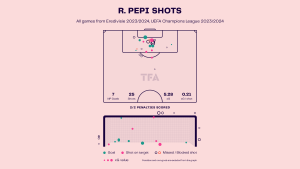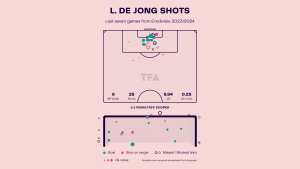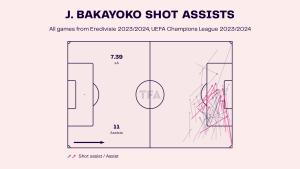For almost 20 years, Ajax striker Klaas-Jan Huntelaar has demonstrated his talents as a clinical goalscorer. From Schalke, to AC Milan, to Real Madrid, to Heerenveen, the now 36-year-old has impressed with his modern take on the role of a ‘traditional’ striker. While he may not feature as heavily in campaigns to the same extent as he once did, he contributions for Ajax this season have been invaluable, chipping in with goals at an impressive rate. His role may have experienced some alteration over the years, but, as this analysis will show you, his reliability has not. This scout report will provide a tactical analysis of Huntelaar, delving into such topics as attributes and tactics that he has been involved in during the 2019/20 campaign.
Position and Role
It comes as no surprise to see Huntelaar’s primary area being in a central position in the penalty area. However, we can also see that he likes to operate a little deeper from time to time across a variety of scenarios. Occasionally, when the opposition have possession, he will drop deeper to apply pressure and also be in an effective position to contribute to an attacking transition when the time comes. Other times will see him drop deeper when Ajax have possession, and Huntelaar will look to receive the ball deeper – either that or he starts deep to then make a penetrating off-the-ball run during an attack, which brings us onto the first section of this analysis, his movement.
Movement
While the veteran isn’t, and honestly never has been, blessed with natural blistering pace, the runs he makes off-the-ball during an Ajax attack serve a great purpose. Knowing that he isn’t the quickest when planning on executing a run in behind, he ensures that prior to this, he is positioned close to the defender he will leave, giving him a slight edge in his movement. These actions aren’t always undertaken to eventually result in the receiving of a pass; Huntelaar often uses his runs as a decoy to drag a defender with him and create space for a nearby teammate.

In the analysis image above, we can see a prime example of Huntelaar executing a run which meets all the before-mentioned points. He runs alongside the defender’s right shoulder before bursting to separate himself and get into space. It is arguable that this run was made with the possibility of reaching one of two outcomes. The first option is that Huntelaar wanted to run at an angle into the channel to receive a direct ball from the right-back, progressing the attack quickly and forcing FC Twente to retreat further to defend. The second option is that Huntelaar was fully aware of Donny van de Beek waiting to join the attack behind him – running into the space behind the defenders would give the midfielder a big chance to position himself in an unoccupied zone between Twente’s midfield and defence which Ajax could exploit in attack.

This second analysis of Huntelaar’s movement shares some similarities to the first, but ultimately serves one purpose – to receive the ball to allow him to shoot on goal. However, with van de Beek in possession on the left, he has two potential targets aside from Huntelaar: the runner on the inside of the Twente left-back, and the runner arriving around the back from the edge of the box. From an Ajax perspective, though, one of the two blue-marked midfielders would’ve made things harder for Twente by filling the space left at the edge of the box and may have even given van de Beek another option. With all that said, Huntelaar is still arguably the best option in terms of creating a goal-scoring opportunity – he just needed the final pass to be better to allow him to take a more effective first touch. However, this shows Huntelaar’s anticipation and game knowledge of where to make a run and how to time it well – a move he has perfect over the years.
Physicality
Now, it has been mentioned already that pace wasn’t one of Klaas-Jan Huntelaar’s most prominent traits, so how has he managed to remain so consistently effective, even away from his goal-scoring prowess? The answer is simple – his attributes surrounding his physicality (strength, aggressiveness etc.) allow him to be useful in instances of winning possession back or retaining the ball for Ajax.

This image showcases Ajax’s pressing tactics when the opposition are on the ball. While several players are busy marking potential passing targets, those close by swarm the player on the ball. As you can see, there are three Ajax bodies surrounding the Twente player in possession, which is done to stop any further progress being made – be it a pass or dribble. However, this pressing move is spearheaded by Huntelaar in this case. The striker has tracked back and closed in on the Twente player, using his strength to affect his balance, limiting Twente’s chances of progressing the attack. Huntelaar’s challenge finally becomes too much and forces a turnover in possession; the players in close proximity can now be just as useful in the transition attack as they were in stopping Twente’s attack.

Here we have an example of Huntelaar proving his worth as Ajax are forced to temporarily adopt an alternative style of play that differs from their typical tactics. Instead of being able to play the ball out at their own pace, going long from Andre Onana up to Huntelaar was the safest option in terms of avoiding danger, but it also gave Ajax the chance of a quick break. As you can see, Huntelaar faces a tough challenge of beating two Twente players in an aerial duel. The striker wins the initial header and manages to reposition himself impressively to win the second loose ball, laying it off to Hakim Ziyech just behind him. This is a vital victory in the air as it stops Twenty regaining possession in a dangerous zone, but Ajax were also already set up for an attack, with wingers on either side ready to exploit spaces around the respective full-backs marking them.
Huntelaar’s work rate and defensive contributions can also be seen in the table and graph below, proving that it is, in fact, a staple of his style of play.
The first graph shows his rate of total recoveries and rate of counter-pressing per 90 minutes. While both stats (1.37 recoveries & 0.78 counter-pressing recoveries) rank low compared to the rest of the Eredivisie, it is important to remember the key factors leading to this – Ajax’s dominant style of play often requires less defensive input from the striker; and secondly the graph includes the statistics of all outfield players, meaning midfielders and defenders (who will naturally have higher numbers in these regions) are included. What the graphs do demonstrate, along with the numbers from the table presented underneath them, is that Huntelaar has a lot to offer in terms of assisting in regaining possession high up the field.
Goal Contribution
Despite playing just 1233 minutes across 32 games in all competitions, Klaas-Jan Huntelaar has still contributed 10 goals and three assists for his side. He has been more effective in the Eredivisie than in any other competition in the 2019/20 season, scoring nine goals in just 839 minutes (18 games), averaging 0.88 goals per 90 minutes, an incredibly impressive figure for someone of his age. Through the season, he has a goal conversion rate of 25.5%, highlighting his importance to this Ajax teams – he scored important goals. The images of analysis below will give a visual representation of how crucial he can be.

This analysis encapsulates everything that is great about Klaas-Jan Huntelaar. The attacking move was only able to begin after Huntelaar himself applied high pressure to an opponent to win the ball back, before passing to a teammate. While the ball bounced around the penalty area, he patiently held back at the edge of the box, anticipating a loose ball. Indeed, the loose ball arrived and Huntelaar unleashed a vintage first-time shot to beat the keeper. To be able to demonstrate such an array of qualities before showing your true talent as a natural finisher is a rarity in the modern game.
Conclusion
Successful strikers are defined as such due to their goal-scoring ultimately. While Klaas-Jan Huntelaar is arguably one of the best and most consistent natural finishes Europe has seen in the last 10-15 years, it isn’t just his finishing ability that has earned him such a reputation. His work rate, physical talent, and defensive assistance all make up his game which has helped so many teams win trophies over the years. Being part of the current Ajax team gives him the chance to guide the younger talent around him, both on and off the field, as well as still contributing with an impressive number of goals. Although his days of scoring 30 goals a season are behind him, he will be missed by Ajax when he finally hangs up the boots.











